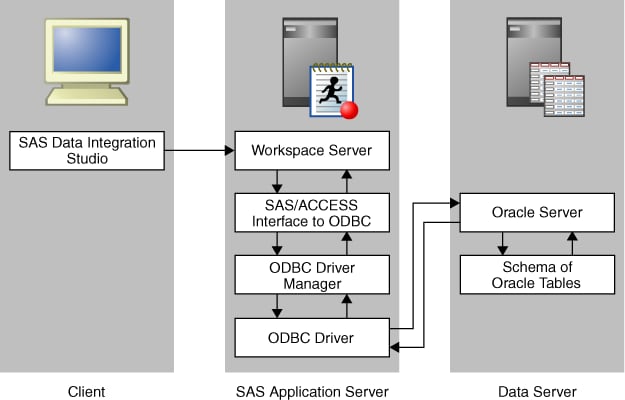Establishing Connectivity to an Oracle Database By Using ODBC
Overview of Establishing Connectivity to an Oracle Database by Using ODBC
The following figure
provides a logical view of using Oracle as a data source and connecting
to the database with a SAS/ACCESS ODBC interface.
Setting up a connection
from SAS to an Oracle database management system by using ODBC is
a three-stage process:
This example shows the
process for establishing a SAS connection to an Oracle database. It
assumes that the software for the database has already been loaded
with the standard installation wizard for the database client. Before
you begin, satisfy the following prerequisites:
-
installation of SAS/ACCESS Interface to ODBC. For configuration information, go to the Install Center at http://support.sas.com/documentation/installcenter/93 and use the operating system and SAS version to locate the appropriate SAS Foundation Configuration Guide.
-
(UNIX only) configuration of SAS/ACCESS environmental variables. For information about setting environmental variables when you use SAS/ACCESS to connect to data on UNIX systems, see Setting UNIX Environment Variables for SAS/ACCESS.
Stage 1: Define the ODBC Data Source
First, you must define the ODBC data source. To define the ODBC data
source on Window systems, perform the following steps:
-
Click Add to access the Create New Data Source dialog box. Click the Oracle driver listed in the window (for example, Oracle in OraClient10g_home1). Click Finish to access the Oracle ODBC Driver Configuration dialog box.Note: System data sources and user data sources store information about how to connect to the indicated data provider. A system data source is visible to all users with access to the system, including Windows services. A user data source is visible only to a particular user, and it can be used on the current machine only. For this example, we are creating a system data source.
Stage 2: Register the Database Server
-
Connection Properties
ODBCAuth(You might need to create a new authentication domain. For more information, see How to Store Passwords for a Third-Party Server in SAS Intelligence Platform: Security Administration Guide.) Click New to access the New Authentication Domain dialog box. Then enter the appropriate value in the Name field and click OK to save the setting.
Stage 3: Register the Database Library
After you have registered the database server, you
can register the database library. To register the database library,
perform the following steps:
-
Examine the final page of the wizard to ensure that the proper values have been entered. Click Finish to save the library settings. At this point, register tables as explained in Registering and Verifying Tables.

